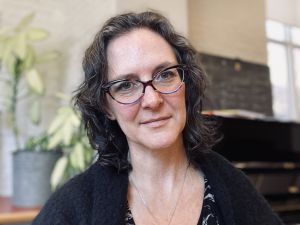 Melanie Grice, a second-year concurrent education student who is also working toward her Bachelor of Science, is one of the new faces in Brock's succesful Both Sides of the Brain campaign.
Melanie Grice, a second-year concurrent education student who is also working toward her Bachelor of Science, is one of the new faces in Brock's succesful Both Sides of the Brain campaign.
Melanie Grice, a second-year concurrent education student who is also working toward her Bachelor of Science, is one of the new faces in Brock's successful Both Sides of the Brain campaign.
The latest numbers show that Brock’s marketing strategists were using their heads when they launched the University’s Both Sides of the Brain campaign.
The marketing strategy, which features one half of a student or faculty member’s face merged with an image depicting their personal or professional ambitions, has resulted in more people knowing about Brock and more students accepting offers to study here.
That’s exactly what the University wants, said Dean Lorenz, Brock’s associate director of marketing.
“The statistics show it’s working,” Lorenz said. “People have to keep that in mind. If they don’t like the campaign or a particular image, that’s not the point of the campaign. It’s to cut through the clutter and these images stick in students minds.”
And how:
• Awareness of Brock has risen from 35 per cent in 2008 to 78 per cent in 2009 when the campaign launched, and 88 per cent in 2010.
• Students who applied to attend Brock were also very familiar with the split images. Seventy-seven per cent of them said they were aware of the campaign.
• There are also few detractors among students, thanks to 87 per cent who said they liked the Both Sides of the Brain concept. They used words such as clever, intelligent and eye-catching to describe the images.
• Brock is also experiencing its highest conversion rate in a decade, which means more applicants – 28.4 per cent of them – are accepting offers to study here. That’s up more than three per cent since the campaign kicked off.
• There has also been a 26 per cent jump in applicants with a high school average of 90 per cent or more.
The numbers were calculated by Brock’s Admissions office and Ken Steele of Academica Group Inc., a Canadian higher education marketing consulting firm. Steele noted how remarkable the campaign’s results are.
“To get numbers like that, he said he has never seen a campaign generate that kind of response in that short a time,” Lorenz said. “He said that’s double or triple other campaigns he’s seen.”
Both Sides of the Brain, which was developed with the help of Newfoundland firm Target Marketing, has become “distinctly Brock,” he added.
It has also received accolades from the Council for Advancement and Support for Education (CASE), winning six awards in the past three years.
So what’s the appeal?
“(Students) can see themselves in it and they say it shows – they’ve used the words ‘(Brock) makes you more well-rounded,” Lorenz said. “It makes them feel they belong here.”
Brock’s marketing team is working on a new batch of images for the campaign, which already has a library of about 60.
Nineteen researchers, including professors, and graduate and undergraduate students will be the latest faces used in an effort to promote the University’s new Cairns Family Health and Bioscience Research Complex.










This campaign is actually starting to get old, I’ve seen it used in the UK, mid-90’s.
To say that the campaign drove numbers up in enrollment – wouldn’t the economy of our area have something to do with increased enrollment at a local university, rather than pay more for lodging and tuition – as well as other departments…working towards increasing their respective numbers for enrollment.
The marketing department plays a “wait and see” game then gauges response, not so proactive if you ask me, more reactive. It is time for a new campaign, esp. when there are new buildings to open to the public.
It’s not old for me. I saw this campaign for the first time on the Go train last year. It showed a guy with a 99%+ high school average with a painting of him playing the sax. I didn’t think of Brock much before I saw it. It got my attention.
This article would be more meaningful if it provided a better context for the interpretation of the data selectively provided. As it is, it reads more like a corporate fluff-piece instead of real news.
In particular, we are told there are more conversions. Are all universities experiencing higher conversions, which would suggest that the number of university places in the system is more closely balanced with the number of students in the system? Or is Brock becoming more competitive in attracting students?
Furthermore, the number of students applying with a 90% or higher average is up. Is this because there are more students in the high school system with this average (which points to grade inflation)? Or is it because Brock is actually doing a better job attracting students? To what degree does this have to do with shortages of openings at other (possibly more prestigious) universities?
Given that the article does not answer either of these questions, I would suspect that Brock’s apparent improvement is actually a result not of the marketing campaign, but larger structural features in Ontario’s higher education system (i.e., a tightening up in the number of openings relative to the number of students).
Hi Jeff,
As a professor, you are aware of some stats that Admissions, Recruitment and Marketing collect. There are likely many more that are behind the scenes, used in strategic enrollment management. Rather than bore readers with all the minutia of that, Tiffany chose to provide some highlights.
I no longer work at Brock, but I still strongly believe in the campaign’s performance. The campaign is one part of many successful student attraction/recruitment efforts of the Faculties, the Co-op Program Office, Recruitment, Admissions, etc.
In re-reading my comment, I realize I was too snarky. I apologize to the author for referring to this piece as “corporate fluff.”
I have used the pictures from this ad for the past 2 years in my junior visual arts classes with much success. The lesson gets the students drawing facial features with a focus, since it’s their face, and makes their minds begins to really think about their future. The kids, and I, love the lesson. Thanks!